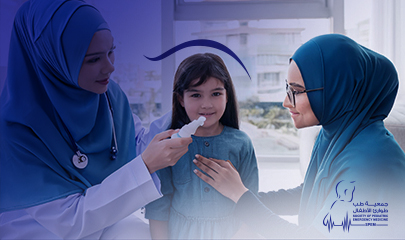الإسعافات الأولية للأطفال: دليلك للتعامل مع الطوارئ بفعالية

Accidents and sudden injuries can happen at any time, especially to children who explore the world around them without realizing potential dangers. In such situations, a quick response and knowledge of basic first aid can be crucial in preventing complications and even saving a child’s life.
The Importance of Learning First Aid for Children
First aid is not just an additional skill; it is essential for every parent, teacher, or caregiver. It helps to:
- Reduce complications from injuries and accidents.
- Save a child’s life in critical situations such as choking or severe bleeding.
- Respond calmly and confidently in emergencies instead of panicking or reacting incorrectly.
First Aid Procedures for Common Childhood Emergencies
1. Managing Choking
Choking is one of the most dangerous situations that can threaten a child’s life, especially while eating or playing with small objects.
What to do:
- If the child can cough, encourage them to continue to help dislodge the object.
- If they are unable to breathe, perform the Heimlich maneuver:
- Stand behind the child and wrap your arms around their waist.
- Place one hand in a fist just below the ribcage and push upward with moderate force.
- Repeat until the object is expelled or the child loses consciousness (if so, start CPR immediately).
2. Managing Severe Bleeding
Deep wounds can cause heavy bleeding, so it’s crucial to act quickly to stop it.
What to do:
- Apply pressure to the wound with a clean cloth or bandage.
- Elevate the injured limb above heart level to slow blood flow.
- If the bleeding doesn’t stop within 10 minutes or the wound is very deep, seek medical help immediately.
3. Treating Burns
Burns can result from hot water, electrical appliances, or direct flames.
What to do:
- Run cold water over the affected area for 10-15 minutes.
- Do not apply ice directly to the burn, as it may worsen tissue damage.
- If the burn is severe, cover it with a clean cloth and seek medical attention immediately.
4. Performing CPR in Cases of Unconsciousness
If a child stops breathing, CPR (Cardiopulmonary Resuscitation) can be life-saving.
What to do:
- Check if the child is breathing. If unresponsive, call emergency services immediately.
- Lay the child on a flat surface and start 30 chest compressions using the palms of your hands, followed by two rescue breaths.
- Continue until the child regains consciousness or medical help arrives.
5. Handling Poisoning
Children may accidentally ingest toxic substances like medications or household cleaners.
What to do:
- Do not induce vomiting, as this may worsen the damage.
- Identify the substance ingested and call a poison control center immediately for guidance.
- If the child is unconscious, rush them to the hospital immediately.
What to Do After Giving First Aid?
After managing the emergency, it is essential to:
- Monitor the child for any unusual symptoms.
- Visit a doctor if needed, even if the child seems fine.
- Educate children about potential hazards and how to avoid them.
Knowing first aid can mean the difference between life and serious complications. Always ensure you learn essential first-aid skills and keep a well-equipped first-aid kit at home and in your car. Preparedness and quick action can be the key to saving your child’s life!
